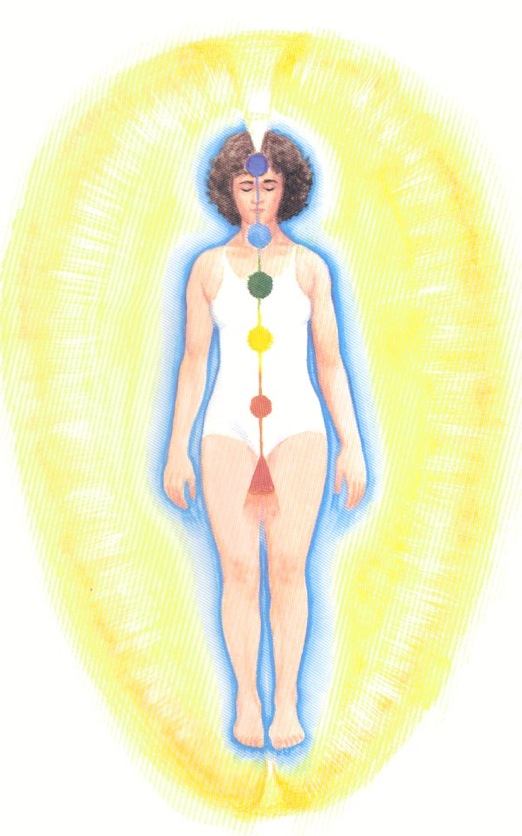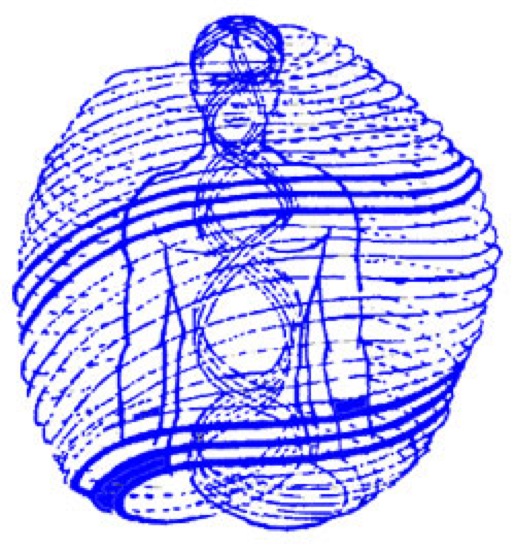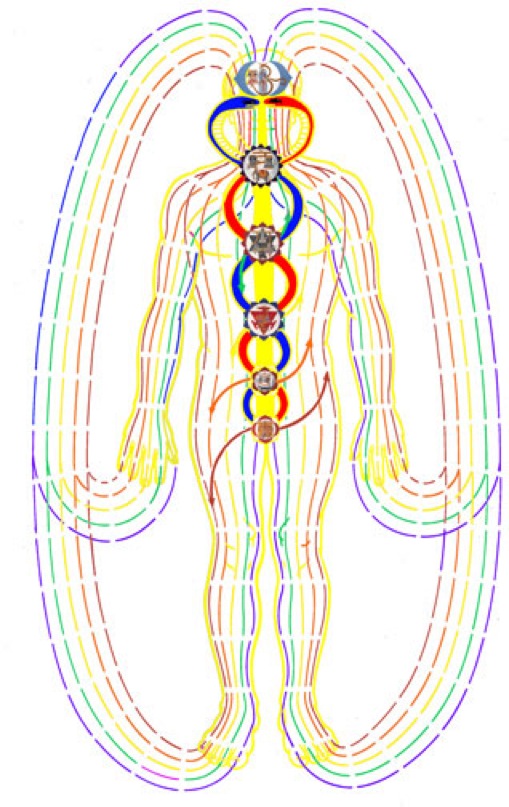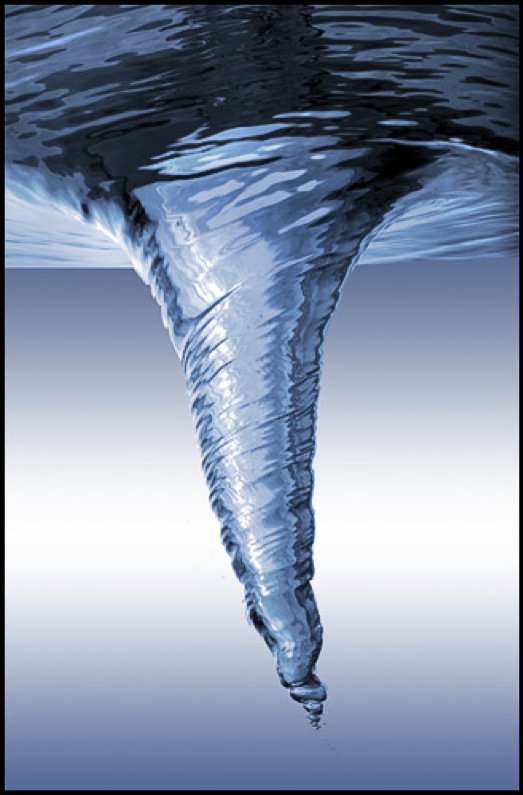Approaching Meditation
Your meditation practice is mostly open-eye. Just dig it there, and only when you really feel like it, the eyes close. Or let the eyes be open or closed as is your preference in the moment, no rules.
The basic attitude is a wide-open embrace of life. That is you. And the purpose of meditation is to support you in that, tune you up for that, because it is always possible to be better. Even world-class athletes and musicians practice.
Pranayama
Salt air
Then simply cherish the flow of air and the feeling of expansiveness.
The feeling is, “I cherish the gift of life.”
Jasmine
I delight in the sweet fragrance of life.
Earth
I am grateful to the Earth for supporting us.
The feeling here is of breathing out, and releasing into the Earth. This is an apana practice.
Madhyama Centering Practice
Madhya means “the center” and also, being centered. In Tantra, the word madhyama means mediating, and refers also to the intersection of rhythms, the center point where the rivers of life flow together.
Your madhyama practice is simple. Throughout the day, return again to the thought and feeling,
“I am centered in the creative swirl.”
Develop the ability to remember to do that for awhile. It always takes me time to add something like that to my awareness. Keep in mind that you are already doing this. So you are just affirming the life you have created: you live every day surrounded by creative females. So the tone of this practice can be rejoicing - “I AM centered, yahoo! In the creative swirl, wow.” It can also be a command to yourself, an affirmation, if you feel you are losing your center. You can also sit and do this, and rest in your center.
Rasa Practices
Sweet
Sweets are very important to you, and you can’t fight it. Your practice is totally simple. Embrace your craving for sweet things, and pay total attention when you eat and drink them. With chocolate, let it melt on your tongue. Don’t chew until it is all melted. With wine, put your attention right in the center of your tongue and be there to receive the blessing.
As a kind of mantra, say the word, sweet, out loud or to yourself when you are eating and drinking sweet things. Get really into sweet as a word you are cherishing. Over time, you can develop a bigger vocabulary for tastes. Have Shan teach you the adjectives for describing wine, if you don’t already know them. Or, secretly study one of the wine books and then surprise Shan.
Develop your ability to perceive, enjoy, delight in, and even name the many different tastes that hit the tongue when eating chocolate and drinking wine. Take tiny bites and sips and learn to maximize the amount of sheer pleasure you get. This is your path, dude.
Why not secretly learn many of these adjectives, these descriptors, and make a kind of joke out of using them, just to delight yourself and your beloved?
Tasting Descriptors, for example:
- Accessible A wine that is easy to drink without an overwhelming sense of tannin, acidity or extract.
- Aftertaste A term for the taste left on the palate after wine has been swallowed. "Finish" is a synonym.
- Aggressive A wine with harsh and pronounced flavors. The opposite of a wine described as "smooth" or "soft"
- Alcoholic A wine that has an out of balanced presence of too much alcohol.
- Astringent An overly tannic white wine.[2]
- Acidic A wine with a noticeable sense of acidity.[3]
- Aroma The smell of a wine. The term is generally applied to younger wines, while the term Bouquet is reserved for more aged wines.
- Austere A wine that is dominated by harsh acidity or tannin and is lacking the fruit needed to balance those components.
- Autolytic Aroma of "yeasty" or acacia-like floweriness commonly associated with wines that have been aged sur lie.
- Baked A wine with a high alcohol content that gives the perception of stewed or baked fruit flavors. May indicate a wine from grapes that were exposed to the heat of the sun after harvesting.
- Balanced A wine that incorporates all its main components—tannins, acid, sweetness, and alcohol—in a manner where no one single component stands out.[4]
- Big A wine with intense flavor, or high in alcohol.[5]
- Biscuity A wine descriptor often associated with Pinot noir dominated-Champagne. It is sense of yeasty or bread dough aroma and flavors.
- Bite A firm and distinctive perception of tannins or acidity. This can be a positive or negative attribute depending on whether the overall perception of the wine is balanced.
- Bitter An unpleasant perception of tannins.
- Blowzy An exaggerated fruity aroma. Commonly associated with lower quality fruity wines.
- Body The sense of alcohol in the wine and the sense of feeling in the mouth.[2]
- Bouquet The layers of smells and aromas perceived in a wine.[2]
- Bright Describes a wine that has high clarity, very low levels of suspended solids.
- Buttery A wine that has gone through malolactic fermentation and has a rich, creamy mouthfeel with flavors reminiscent of butter.
- Cassis The French term for the flavors associated with black currant. In wine tasting, the use of cassis over black currant typically denotes a more concentrated, richer flavor.
- Cedarwood A collective term used to describe the woodsy aroma of a wine that has been treated with oak.
- Charming A subjective term used to describe a wine with a range pleasing properties but nothing that stands out in an obvious fashion.
- Chewy The sense of tannins that is not overwhelming.[2]
- Cheesy An aroma element characteristic of aged Champagne that develops after an extended period of aging. It is associated with the aroma of aged, nutty cheeses such as gouda and is caused by a small amount of butyric acid that is created during fermentation and later develops into an ester known as ethyl butyrate.
- Chocolaty A term most often used of rich red wines such as Cabernet Sauvignon and Pinot noir that describes the flavors and mouthfeel associated with chocolate--typically dark.
- Cigar-box An term used to describe the tobacco aromas derived from oak influence.
- Citrous A wine with the aromas and flavor from the citrus family of fruits.
- ▪ Definition A wine that not only is well balanced but also gives a clear expression of its grape variety or place of origin.
- Delicate A term used similar to charm but more often relates to the more subtle notes of a wine.
- Depth A term used to denote a wine with several layers of flavor. An aspect of complexity.
- Dirty A wine with off flavors and aromas that most likely resulted from poor hygiene during the fermentation or bottling process
- Dry A wine that is lacking the perception of sweetness.[3]
- Dried up A wine that has lost some of its freshness or fruitiness due to extended aging.
- Earthy This can mean a wine with aromas and flavor reminiscent of earth--such as forest floor or mushrooms. It can also refer to the drying impression felt on the palate caused by high levels of geosmin that occur naturally in grapes.
- Easy A term that can be synonymous with "approachable" but more commonly refers to a wine that is simple and straightforward without much complexity but still enjoyable to drink.
- Edgy A wine with a noticeably level of acidity that heightens the flavors on the palate. Maybe synonymous with "nervy"
- Elegant A term to describe a wine that possess finesse with subtle flavors that are in balance.
- Expansive A wine that is considered "big" but still accessible.
- Expressive A wine with clearly projected aromas and flavors.[8]
- Fallen over A wine that, at a relatively young age, has already went past its peak (or optimal) drinking period and is rapidly declining in quality is said to have "fallen over".
- Farmyard A generally more positive term than "Barnyard" used to describe the earthy and vegetal undertones that some Chardonnay and Pinot noir develop after maturing in the bottle. While for some wine drinkers this may not be very appealing, for others this maybe a sign that the wine has entered its peak drinking period.
- Fat A wine that is full in body and has a sense of viscosity.[5] A wine with too much fat that is not balanced by acidity is said to be "flabby" or "blowzy"
- Feminine Describes a wine that emphasize more it delicate flavors, silky textures and subtle aromas rather strength, weight and intensity of fruit.
- Finish The sense and perception of the wine after swallowing.[5]`
- Finesse A very subjective term used to describe a wine of high quality that is well balanced.
- Firm A stronger sense of tannins.[2]
- Flabby A lacking sense of acidity.[5]
- Flat In relation to sparkling wines, flat refers to a wine that has lost its effervescence. In all other wines the term is used interchangeably with "flabby" to denote a wine that is lacking acidity, particularly on the finish.
- Fleshy A wine with a noticeable perception of fruit and extract.
- Foxy A tasting term for the musty odor and flavor of wines made from Vitis labrusca grapes native to North America, usually a negative term.[9]
- Fresh A positive perception of acidity.[2]
- Fruit The perception of the grape characteristics and sense of body that is unique to the varietal.[2]
- Full A term usually used in context of wine with heavy weight or body due to its alcohol content. It can also refer to a wine that is full in flavor and extract
- Grapey A wine with the aromas and flavors reminiscent of grape flavoring--such as those associated with grape jelly. The Muscat family of grapes often produce wines that are described as "grapey".
- Grassy A term used to describe an herbaceous or vegetal element of a wine--ranging from freshly mown lawn grass to lemon grass flavors.
- Green Overly acidic wine. Typically used to describe a wine made from unripe fruit.[5]
- Gutsy A wine with noticeable body, extract and fruit.
- Hard Overly tannic wine.[2]
- Harsh Similar to "coarse" but usually used in a more derogatory fashion to denote a wine that has unbalanced tannins and acidity.
- Heavy A wine that is very alcoholic with too much sense of body.[5]
- Herbaceous The herbal, vegetal aromas and flavors that maybe derived from varietal characteristics or decisions made in the winemaking process-such as harvesting under-ripened grapes or using aggressive extraction techniques for a red wine fermented in stainless steel.
- Hollow A wine lacking the sense of fruit.[2]
- Hot Overly alcoholic wine.[5]
- Inky A term that may refer to a wine's dark coloring and opacity.
- Jammy A wine that is rich in fruit but maybe lacking in tannins.
- Lean The sense of acidity in the wine that lacks a perception of fruit.[2]
- Legs The tracks of liquid that cling to the sides of a glass after the contents have been swirled. Often said to be related to the alcohol or glycerol content of a wine. Also called tears.
- Lemony A term referring to the tangy acidity of a wine with fruit flavors reminiscent of lemons.
- Lightstruck A tasting term for a wine that has had long exposure to Ultraviolet light causing "wet cardboard" type aroma and flavor.
- Linalool The characteristic flowery-peach aroma associated with Muscat and Riesling wines. It derived from the chemical compound linalool.
- Liquorice A term used to describe the concentrated flavor from rich sweet wines such as those of Monbazillac AOC which are produced by botrytized grapes.
- Liveliness A term used to describe a wine with slight carbonation and fresh, bright acidity.
- Luscious Similar to "voluptuous" but more commonly associated with sweet wines that have a rich, concentrated mouthfeel.
- Mature A wine that has aged to its peak point of quality.[2]
- Mean A wine without sufficient fruit to balance the tannins and/or acidity of the wine, making it unbalance and unpleasant to drink.
- Meaty A wine with a rich, full body (and often pronounce tannins and extract) that gives the drinker the impression of being able to "chew" it.
- Mellow A wine with a soft texture that is nearing the peak of its maturity.
- Midpalate A tasting term for the feel and taste of a wine when held in the mouth.
- Minerality A sense of mineral-ness in the wine, flavors of slate, shist, silex, etc
- Nervy A wine with a noticeable amount of acidity but is still balanced with the rest of the wine's components
- Nose A tasting term for the aroma or bouquet of a wine.
- Oaky A wine with a noticeable perception of the effects of oak. This can include the sense of vanilla, sweet spices like nutmeg, a creamy body and a smoky or toasted flavor.[3]
- Oily A generally full bodied wine with a viscous mouthfeel. If the wine is lacking acidity, this term maybe used in conjunction with flabby.
- Opulent A rich tasting wine with a pleasing texture mouthfeel that is well balanced.
- Oxidized A generally negative term describing a wine that has experienced too much exposure to oxidation. A wine that has been oxidized, is considered faulty and may exhibit sherry-like odors.
- Oxidative Unlike "oxidized", this is generally a more positive term describing a wine that has experienced constrained exposure to oxidation over the course of its aging process. The aromas and flavors that develop as a wine oxidatively matures can range from nuttiness, biscuity and butteriness to more spicy notes.
- Palate A tasting term for the feel and taste of a wine in the mouth.
- Peak The point where a wine is at its most ideal drinking conditions for an individual taster. This is a very subjective determination as for some tasters a wine will be at its peak when the fruit is still fresh and young while for some tasters the peak will arrive when a wine has matured in flavor.
- Peppery A wine with the aromas and flavors reminiscent of the fruit from the Piper family of plants such as black peppercorn associated with Syrah and Grenache based wine or the aroma of crushed white pepper associated with Gruner Veltliner.
- Perfume A generally positively used to describe an aspect of a wine's aroma or bouquet.
- Plummy A wine with the juicy, fresh fruit flavors of plum
- Polished A wine that is very smooth to drink, with no roughness in texture and mouthfeel. It is also well balanced.
- Powerful A wine with a high level of alcohol that is not excessively alcoholic.[2]
- Prickly A wine with some slight residual carbonic gas, though not necessarily to the point of the wine being considered a sparkling wine. Some very young white wines (such as Vinho Verde) and dry rosé may be described as "prickly"
- Racy A wine with noticeable acidity that is well balanced with the other components of the wine.
- Reticent A wine that is not exhibiting much aroma or bouquet characteristics perhaps due to its youth. It can be described as the sense that a wine is "holding back".
- Rich A sense of sweetness in the wine that is not excessively sweet.[2]
- Robust A term with similar connotations as "aggressive" except that "robust" is more commonly applied to older, mature wines while "aggressive" tends to describe younger wines.
- Round A wine that has a good sense of body that is not overly tannic.[2]
- Sassy A wine with bold, brash and audacious flavors.
- Sharp A term normally used to describe the acidity of a wine though it can refer to the degree of bitterness derived from a wine's tannin.
- Sherrylike A term used to describe a non-Sherry wine that exhibits oxidized aromas that may have been caused by excessive amounts of acetaldehyde.
- Short A wine with well develop aromas and mouthfeel but has a finish that is little to non-existent due to the fruit quickly disappearing after swallowing.
- Smokey A wine exhibiting the aromas and flavors of the various types of smoke, such as tobacco smoke, roasting fire smoke and a toasty smoke derived from oak influences.
- Smooth A wine with a pleasing texture. Typically refers to a wine with soft tannins.[5]
- Soft A wine that is not overly tannic.[2]
- Spicy A wine with aromas and flavors reminiscent of various spices such as black pepper and cinnamon. While this can be a characteristic of the grape varietal, many spicy notes are imparted from oak influences.
- Stalky A woody, green herbaceous note in a wine.
- Structure A term used to describe the solid components of a wine-acidity, sugar, density of fruit flavors and phenolic compounds such as tannins in relation to the overall balance and body of the wine.
- Supple A wine that is not overly tannic.[2]
- Sweet A wine with a noticeable sense of sugar levels.[3]
- Tannic A wine with aggressive tannins.[3]
- Tart A wine with high levels of acidity.[2]
- Texture A tasting term for the mouthfeel of wine on the palate.
- Thin A wine that is lacking body or fruit
- Tight A wine with a significant presence of tannins that is restraining the other qualities of the wine, such as fruit and extract, from being more noticeable. A "tight wine" is expected to age well as the tannins soften to reveal these other qualities.
- Toasty A sense of the charred or smoky taste from an oaked wine.[3]
- Transparency The ability of a wine to clearly portray all unique aspects of its flavor--fruit, floral, and mineral notes. The opposite would be a wine where flavors are diffused and thoroughly integrated.[10]
- Typicity A wine tasting term used to describe how much a wine expresses the typical characteristics of the varietal.
- Unoaked Also known as unwooded, refers to wines that have been matured without contact with wood/oak such as in aging barrels.
- Undertone The more subtle nuances, aromas and flavors of wine.
- Upfront A wine with very perceivable characteristics and quality that do not require much thought or effort to discover.
- Vanilla An oak induced characteristic aroma reminiscent of vanilla.
- Vegetal A wine with aromas and flavor reminiscent of vegetation as oppose to fruit or floral notes.
- Vivid A wine with very expressive ripe, fruit flavors.
- Voluptuous A wine with a full body and rich texture.
- Warm A wine with noticeable but balanced alcohol as opposed to a wine with excessive alcohol that maybe described as "hot". It can also refer to a creamy texture derived from oak treatment.
- Watery A wine that is excessively "thin" in body and fruit.
- Yeasty Often uses synonymously with "biscuity" and can describe a wine with aromas and flavor reminiscent of bread dough or biscuits.
- Young Wine that is not matured and usually bottled and sold within a year of its vintage.
- Zesty A wine with noticeable acidity and usually citrus notes.
- Zippy A wine with noticeable acidity that is balanced with enough fruit structure so as to not taste overly acidic.
Wine Tasting Descriptors at Wikipedia
The Creative Swirl
In general, just for yourself, use English instead of Sanskrit wherever possible. Some day, you may come to prefer Sanskrit, but if that ever happens, you’ll know. That being said, let’s talk about the energy fields around the body, and the nature of your magnetism specifically.
When you are doing your madhyama centering practice, which you can call just, centering, know that your energy field goes out 20 feet or more in all directions, touching, sensing needs, responding, attending, managing, directing. You are superb at this, it is manager energy, gently encouraging everyone to do their job, to show up, and you are responsible.
Just to get a sense of how rich and interesting a magnetic field is, look at these images, and then think of them as movies, in continual motion, ever-swirling, and never exactly the same from one moment to the next, and very layered, holographic. Then forget about it, and just rejoice in your natural sensing mode. As I said to you, a feeling is worth a thousand pictures. Feeling is better than seeing.
Remember, your natural sensing mode is to feel and respond to need immediately. You call it your gut instinct. I’m just giving you a little bit of mirroring here.
Think of your swirl as being almost as large as your house. This one is tiny.

Found here.
Shannon looks a tiny bit like this sometimes, only with a bigger field.

Here is a kinda interesting perception of the swirl

Found at Golden Ratio
And here


Link to a short movie visualizing the chakras, by Anodea Judith, Alex Wayne, and Robin Silver.
Vortexes in Nature
The energy vortexes - or chakras, as they are called in Sanskrit, have similarities to vortexes in water and air.
A vortex in water. Photo by Paul Groom.

Vortex in the air behind an airplane
With all these, don’t impose on yourself. Just explore, and see if it works for you. Always go by what works for you and helps you to make each day a better day.
